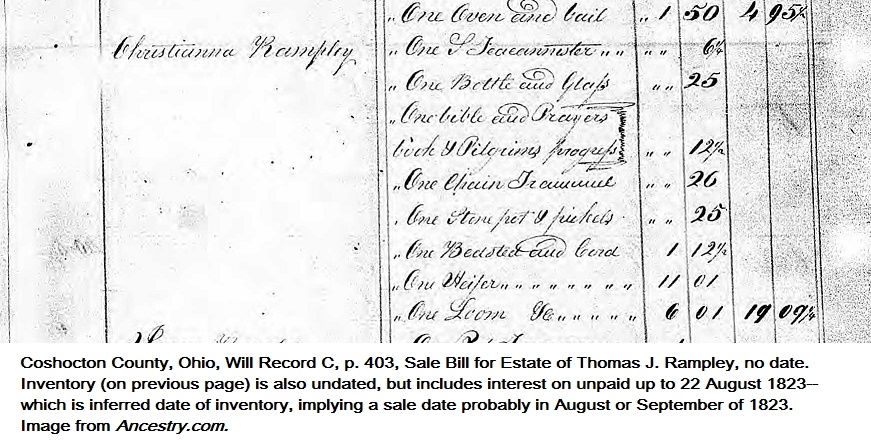
Women were not frequent bidders at estate auctions in the early 1820s. There was only one woman who purchased items from the estate of Thomas J. Rampley in 1823: Christianna Rampley.
It was not unusual for widows to purchase items from their husband’s estate, particularly if husband died intestate. In some states, state statute gave a specific amount of property to the widow–even if there was a will. That award was usually very cleverly titled the “widow’s award.” Apparently there was no such award in Ohio in 1823. Reading contemporary statute would confirm this conclusion.
Christianna’s purchase of property at the sale would indicate she was alive on the date of the auction. In this case, she is known to have lived until at least 1830 (she’s in the census), but if I had no idea of her death date this record would have at least extended the amount of time she was known to have been alive. Determining the date of the auction was problematic. The list of sold items is recorded immediately after the estate inventory. Neither list of items is dated nor is there a date given indicating when the list of goods sold or inventory are recorded. A careful reading of the estate inventory mentions some debts with accrued interest through 22 August 1823. This allowed the inventory date to be inferred. It’s been assumed that the estate sale took place within a few months of the inventory.
To get a better fix on the date of the sale, a reading of all the references to the estate of Thomas J. Rampley in the probate record books is warranted. There may be an estate accounting that references the specific date of the sale.
Christianna purchased general household goods, including a bed, an oven, a stove pot, and a loom. She also bought the family’s bible and a copy of Pilgrim’s Progress. This suggests Christianna was literate.
The image used in this post was obtained from the Ancestry.com database “Ohio, Wills and Probate Records, 1786-1998.” The Ancestry.com images of these records are not all that crisp and appear (to my untrained eye) to be somewhat pixilated. It may be worth my while, for any images that are difficult to read, to view the actual records on microfilm at the Family History Library. Their microfilm is what was used to make the images at Ancestry.com and the microfilm may allow me to obtain a higher quality image. That’s why my citation needs to include the website used. Otherwise I have no idea where I got the image and that does not allow me to know if there may be another way to get a better image.

2 Responses
You say, “Women were not frequent bidders at estate auctions in the early 1820s.”
Much depends on time and place and estate status. I have relatives whose 1820s estate sales were attended by widow, daughters, female neighbors. Pennsylvania, (West) Virginia, New York and more.
I did not mean to imply that it never happened or was extremely rare, but I think it’s safe to say that the percentage of purchasers at these auctions is definitely skewed towards males. Part of how “frequent” it was depends upon how one defines “frequent” (which I didn’t do and I probably should have used a different word). I do think it was more common for men to purchase at estate auctions during this time period than it was for men and that if only one woman is making purchases at an auction, then it likely is the widow (but not necessarily). I’d also be inclined to research female purchasers at an auction during this for possible familial connections with a little more diligence than I would each and every male purchaser.